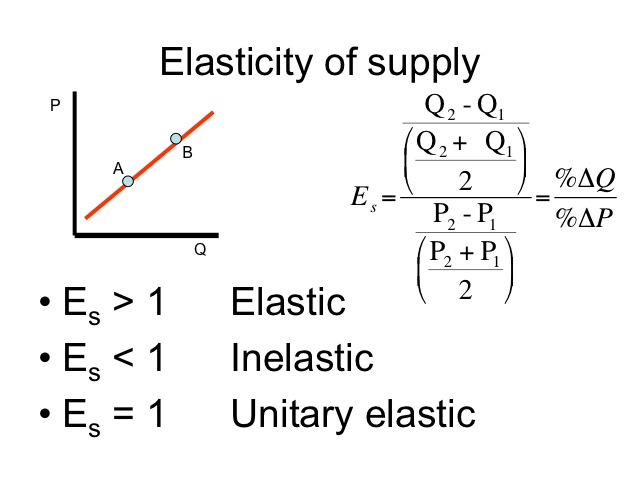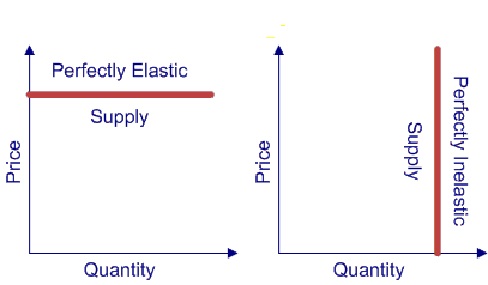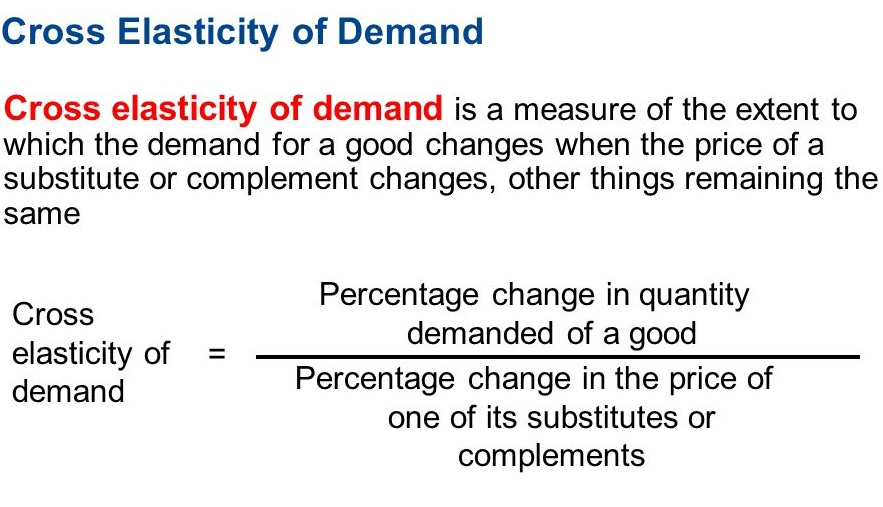Elasticity of Supply and Cross-price elasticity.
Elasticity of Supply is very similar to the elasticity of Demand - it maybe elastic, inelastic or unit elastic. As the name implies it applies to the producer - whether it is beach front property in Southern California or land in Temecula - there is a limited amount of resources.
The formula is very similar to the one for demand - were P1 and Q1 are the original price and quantity. As the image shows values that are greater, less or equal to 1 have different meanings,

There are two extreme cases of elasticity:
- Perfectly inelastic supply - where the producer may not produce more of this product. This typically applies to limited resources such as land (one may not produce more of it).
- Perfectly elastic supply - where the producer may have as much as needed/wanted of this product.. This is mainly a theoretical concept. Below are graphs that represent these extreme cases:

It is important to remember that elasticity provides information to producers so that they may use their resources the most efficient and profitable fashion. There are many factors that apply to production hence elasticity of supply is a very minor factor in production decisions.
Cross Price Elasticity
Cross Price Elasticity provides information regarding two different goods - typically substitute or complementary goods. For example a burger seller would be interested in forecasting what would happen to the quantity of burgers sold if you raise the price of sodas by 10%. (Complementary goods). Or a technology firm may want to predict what will happen to the tablets they sell if they introduce a smaller tablet into the market. (Substitute good)
 When the value of CPE is positive we know that the goods are substitutes - i.e. if the price of meat goes up consumers buy less meat and more chicken. Conversely when the value is negative we have complementary goods - i.e. when the price of coke at a burger joint goes up consumers will buy less burgers.
When the value of CPE is positive we know that the goods are substitutes - i.e. if the price of meat goes up consumers buy less meat and more chicken. Conversely when the value is negative we have complementary goods - i.e. when the price of coke at a burger joint goes up consumers will buy less burgers.
Let's practice!
- Calculate the elasticity of supply based upon the table below. Explain your answer.
PRICE QUANTITY $ $ - Calculate cross-price elasticity of two different goods based upon the table below. Explain your answer.
PRICE of Good A QUANTITY of Good B $ $ - If the value of cross-price elasticity is equal to -1.75 explain what is the relationship between the goods. What would you do with the price of good A if you wanted to sell more of good B? Why?
